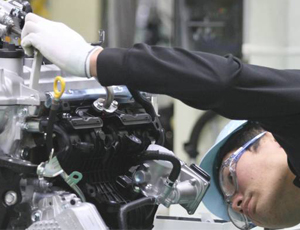Toyota Doubles Its Indonesian Engine Manufacturing Capacity
 Toyota has begun construction of a new US$198 million automotive engine manufacturing plant in Karawang, West Java, which, when completed in 2016, will more than double the company’s current production in Indonesia.
Toyota has begun construction of a new US$198 million automotive engine manufacturing plant in Karawang, West Java, which, when completed in 2016, will more than double the company’s current production in Indonesia.
Toyota announced just two weeks ago they would be pulling out of Australia as a manufacturing base. The plant is expected to produce 216,000 engines per annum, of which half will be for the domestic market and the rest for export to destinations across Asia, Africa and South America. Of the production destined for Asia, Toyota has identified India, Japan, Malaysia, the Philippines, Thailand and Vietnam as being the markets for the Karawang produced engines.
The new plant comes on the heels of Toyota’s existing facility in Sunter, North Jakarta, which produces around 195,000 engines for Toyota’s international multipurpose vehicles, such as the Hilux pickup truck, Innova minivan and the Fortuner SUV.
Chris Devonshire-Ellis of Dezan Shira & Associates comments, “Toyota’s production and export strategy in this deal is a case study in the use of ASEAN and its free trade agreements. Indonesia is a member of ASEAN, and can provide relatively low labor costs and a young, energetic workforce. Japan has a Comprehensive Economic Partnership Agreement with ASEAN, and ASEAN itself also has an FTA with India. The other Asian countries marked out as receiving product from Toyota’s Karawang plant are all ASEAN members in their own right. As for Africa and South America, Indonesia has its own bilateral double tax treaties with Algeria, Egypt, South Africa, Sudan, Tunisia as well as Venezuela, all of which will have impacted upon the economic decisions Toyota has made.”
“Studying the impact of the ASEAN FTAs and the bilateral DTAs with each country is now a prerequisite for working out your global manufacturing and supply chain strategy. The new dynamic of the global supply chain can be seen at work right here in this Toyota deal, and it is ASEAN and not China that is becoming the new global manufacturing base,” he further commented.
You can stay up to date with the latest business and investment trends across Asia by subscribing to Asia Briefing’s complimentary update service featuring news, commentary, guides, and multimedia resources.
Related Reading
 An Introduction to Tax Treaties Throughout Asia
An Introduction to Tax Treaties Throughout Asia
In this issue of Asia Briefing Magazine, we take a look at the various types of trade and tax treaties that exist between Asian nations. These include bilateral investment treaties, double tax treaties and free trade agreements – all of which directly affect businesses operating in Asia.
A Tale of Two Treaties: Toyota’s Australian Exit a Nod to India & the RCEP as Successors?
Indonesia Prepares For Demographic Changes
ASEAN-India Free Trade Area Part II: Indonesia, Vietnam & Myanmar
China’s Agreement with ASEAN – What it Means for China-Based Foreign Manufacturers
- Previous Article Indonesia & Philippines Settle Maritime Boundaries, Look To Increase Trade
- Next Article March 2014 ASEAN Regional Meetings









